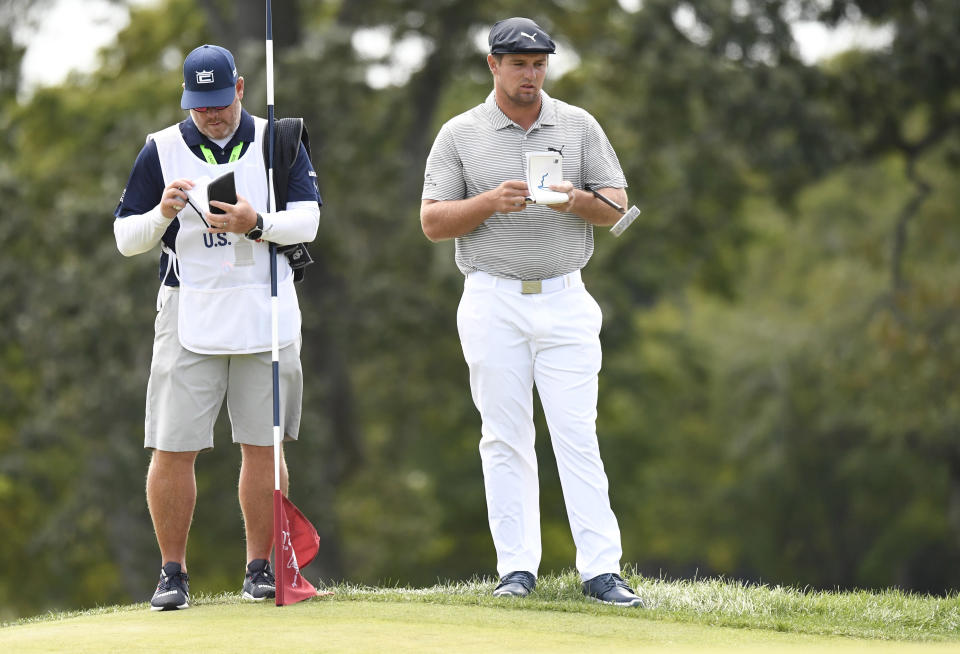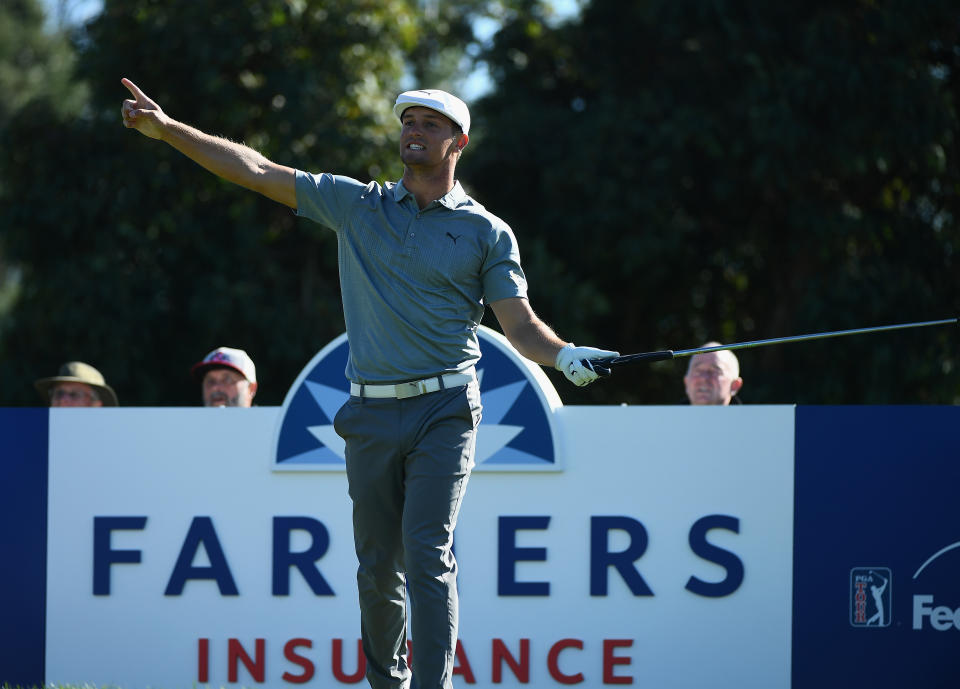‘He found a better way’: Bryson DeChambeau flipped the script (in more ways than one) to win the 2020 U.S. Open at Winged Foot

Editor’s note: This is the first story in a three-part series.
Throughout his 27 years, Bryson DeChambeau has discovered answers to problems confronting him by racking his brain and body, whether devouring a textbook, during strenuous workouts or laborious experimentation.
Simple old observation didn’t hurt, either.
But with the clock ticking ahead of the start of the 2020 U.S. Open at merciless Winged Foot Golf Club in New York, he found a solution in the dark.
DeChambeau was lost as he sent one ball after another after another into the Tuesday night sky the week of the U.S. Open. While he couldn’t see the golf balls land, he had his feel and determination and kept at it until something, anything, felt superior.
“He was struggling and was clearly frustrated. He was 36 hours from teeing off in the first round,” said Ben Schomin, director of Tour Operations for Cobra Puma Golf who has worked with DeChambeau on all things equipment for the golfer’s entire pro career. “I know it’s a cliché that you can’t judge a book by its cover, but if you were reading the first few chapters earlier in the week, you would have been hoping this guy would make the cut.”
DeChambeau, however, turned the page.
“It was tough, it was grueling, it was disappointing,” he said of that Tuesday night. “There were a lot of emotions ahead of this big event you’ve worked so hard to get ready for and you feel like you have a great chance. And I just had to get the driver right. Wednesday, I got to a point where I was somewhat comfortable and then Thursday, I teed it up and felt really comfortable.”
The Tale of DeChambeau at Winged Foot got a late rewrite and took hold the first round as the transformed monster with driver in his hands started to demolish the rugged layout full of tight fairways, hefty rough and unyielding greens.

Bryson DeChambeau chips up onto the eighth green during the final round of the U.S. Open at Winged Foot Golf Club. (Photo by Brad Penner-USA TODAY Sports)
With a 1-under-par 69, he was within touch of the leaders. A 68 in Round 2 put him one shot out of the lead. A third-round 70 set him back two shots and set him back to the range.
“The lasting memory for me from Winged Foot will be the practice session on Saturday night. I was struggling and not doing well and going to the range I had to figure this out,” DeChambeau said. “Worked a couple hours and finally got something I got comfortable with. I was the only one on the range and I wasn’t going to leave until I got comfortable.
“Next morning I felt comfortable. I wasn’t hitting it great but by the sixth hole I knew exactly what I needed to do, but I wouldn’t have been able to get to the sixth hole and figure out what I needed to figure out if it wasn’t for the practice session the night before. That was a testament to the resolve, dedication and perseverance that I have, and my team has, to win.”
Win he did, indeed, as DeChambeau proved his blueprint to go full bore and hit the ball as far as he could, a pre-tournament strategy that was met with doubts and a few laughs, was the proper plan.
His late-night range session Saturday night led to a final-round 67 – he was the only player to break par that Sunday – and it capped a week where he outmuscled bruising Winged Foot and toppled Matthew Wolff by six shots.
DeChambeau reckoned correctly that his speed and strength would save him in the thick rough. His stellar touch on and around the greens made a difference, too.
Despite hitting just 23 of 56 fairways, DeChambeau was the lone player in the red at 6-under 274. With his first major triumph, DeChambeau joined Jack Nicklaus and Tiger Woods as the only players to win a U.S. Amateur, the NCAA individual title and a U.S. Open.

Bryson DeChambeau looks over his putt on the first green with his caddie Tim Tucker during the final round of the 2020 U.S. Open at Winged Foot Golf Club. (Photo by Danielle Parhizkaran-USA TODAY Sports)
The Golden Bear was impressed. The 18-time major winner basically was Bryson before Bryson and could get the better of any rough during his heyday. Nicklaus understood DeChambeau’s reasoning – you’re going to miss a fair share of fairways anyway, so get the ball down as far as you can to have shorter irons in your hand for approaches.
“He figured out that he would be better off with a wedge out of the rough. And he was. He won the U.S. Open with that. That was his philosophy,” Nicklaus said. “Bryson’s a cerebral guy, as you know. Nobody else is going to think about that, to change their whole body to play at a U.S. Open. But he did. And you got to give him credit. You give credit where credit’s due and he did a great job with it and he performed well, he won the tournament, and well done.
“I pretty much did that naturally. I had tree trunks for legs and so it allowed me to really just drive through any rough. There were a lot of golf courses I didn’t worry about much about the rough. I thought what he did was fantastic.”
As did Golf Channel analyst Brandel Chamblee.
“I thought it was brilliant,” he said. “He drove it longer and straighter than anybody in the event by quite a distance, even though his driving distance showed he finished sixth. If you measure every single drive he hit where he hit driver, he was considerably longer than everyone else.
“And then if you measure the dispersion of his shots, he was straighter than everybody else. And then he hit his irons beautifully and putted beautifully.
It was cool to see. Golf had always been taught anecdotally and Bryson was the first person to come along that really did use science to plot out a path to another level of the game.”
Or as on-course commentator and former LPGA star Dottie Pepper said: “He found a better way. He found a way to take what he knew and made it work.”
Especially out of the rough. While Rory McIlroy, who finished eighth that week, was stunned earlier in the year with the hulked-up DeChambeau’s length when the game returned after a 13-week quarantine due to COVID-19, the work he saw his peer do out of the nasty, dense high grass was just as impressive.
“The one thing that people don’t appreciate is how good Bryson is out of the rough,” McIlroy said. “Not only because of how upright he is, but because his short irons are longer than standard. So he can get a little more speed through the rough than other guys.”
That was part of the calculations that led to Team DeChambeau’s plan. Let the big dog eat, if you will, and then, with the ball closer to the green, rely on your other talents.
“It was very rewarding to trust in the process of our game plan even knowing that it may have been considered somewhat unconventional,” said Chris Como, DeChambeau’s coach. “We went in there and had a game plan and trusted it. The results of the win were icing on the cake, the cherry on the top of a sundae.”
DeChambeau never wavered from the plan despite the repeated warnings in the golf biosphere that the rough would eventually wreck his scorecard.
“The swing speed is massive; it just gets the club through the rough better,” Como said. “And the strength and the mass help because he’s able to get his muscles though it. And he also had the strategy of, as the greens get faster, you’re more inclined to stop the ball through trajectory, through the angle of descent than you are through spin.
“So to be able to kind of hit these higher lofted clubs and just throw the ball up as high as he could and basically aim to the middle of the green more or less when you’re coming out of the rough worked.”
This week, DeChambeau, the world No. 4 who counts eight PGA Tour titles and another on the European Tour on his record, defends his U.S. Open victory at Torrey Pines in San Diego. There will be those who will point to DeChambeau’s limited history at Torrey Pines and say he can’t win. And others, despite his success at Winged Foot, will continue to insist his power strategy won’t work on a U.S. Open setup.
Bring on the doubters, said DeChambeau, who missed the cut in the Famers Insurance Open in 2017 and 2018; in his two rounds on the South Course, he shot 78 in 2017 and 76 in 2018. But he finished second in the Junior World on the South Course in 2011.

Bryson Dechambeau plays his shot from the 18th tee during the first round of the Farmers Insurance Open at Torrey Pines South on January 26, 2017, in San Diego. (Photo by Donald Miralle/Getty Images)
While he said he has yet to develop his strategy to attack Torrey Pines, he very well might incorporate the same blueprint he followed at Winged Foot.
“I’m totally fine with people saying Torrey Pines doesn’t fit me,” he said. “I’m quite comfortable with the golf course but I’ve never had the speed I do now going into the South Course. Length was a problem. In 2017 and 2018, I wasn’t hitting it as straight and certainly not as long as I can hit it now.
“And I didn’t have as good a putting game. With my length, with my control out of the rough, with my putting game, I feel I have a great opportunity this year.”
His biggest challenge might be the Poa annua greens, which will get bumpy.
“You have to figure out how to roll the ball well. I’ve always struggled on it but since going to the Sik putter and arm locking and figuring out how to launch the ball more correctly, I’ve become way better on Poa,” DeChambeau said. “Not my favorite, but I have had success on Poa before.”
He very well may again.

